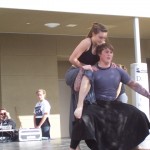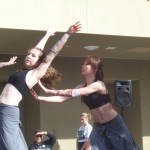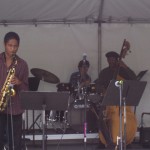By Marcia E. Gawecki
“I’ve seen my show,” said Howard Shangraw, head of the Idyllwild Arts Theater Department, to the cast and crew of “Welcome Home, Jenny Sutter.”
He was giving these students the ultimate compliment. He was pleased with the final rehearsal and their stellar performance. Even if no one came (in the aftermath of a 12-inch snowstorm that hit Idyllwild that weekend), he was happy.
“Welcome Home, Jenny Sutter,” is a modern play that focuses on a wounded Marine now back from Iraq who is trying to “find her way home” through the help of misfits from Slab City. As outlined in the playbill, this show has become part of a national trend of theater performances that are shining a harsh light on Iraq’s seven-year war.
“This is one woman’s story about her own war experience,” Howard said. “If there’s any message here, it’s this: war is hell.”
The show’s stark reality started with the set. In center stage, wrapped around a large pole, was an American flag, our nation’s symbol of freedom. Yet, this one s soiled and tattered, and created from large strips of rags–the backdrop of an brutal story.
Behind the flagpole was a large, floor-to-ceiling video screen that featured flashbacks of ongoing gun battles and bomb explosions complete with sound effects. Other times, it served as a simple scene changer from a hospital, to a bus station, and then to Slab City, Jenny’s remote “haven” in Southern California.
“The video was our idea,” said Howard, proudly. “At one part in the script, the playwright suggested some slide scenes, but we decided that ongoing video and slides would really enhance the show.”
Howard said that Eric Bulrice, the set designer, an award-winning Idyllwild Arts graduate, went to Slab City, and shot stills of its drab, concrete reality, and even found videos of gun battles. Everything worked out well visually, and if there were any glitches during the show on Saturday night, January 23rd, they were not evident to the audience.
The beauty of a small cast, six in all, is that the audience gets to see the characters fully develop. We know their pasts, their idiosyncrasies, their hopes, their dreams and all the while, we’re cheering for them. At the final curtain bow, there wasn’t a dry eye in the house. However, those were not tears of sadness, but of appreciation for a remarkable story well told.
“I couldn’t stop crying for about an hour after the show,” said Dominique DeRoss, a visual arts student, and roommate of Carter Smith, one of the cast members. “I was emotional because I was so proud of my roommate. I know how hard she worked on her performance, and she was so great!”
The show opens with Jenny Sutter, played by Amenta Abioto, being carried into a hospital on a stretcher. “I can carry my own weight!” she snaps at the two Marines, giving us a taste of her exploding anger, frustration and bitterness. It’s also where we first learn that Jenny has a prosthetic leg, a war wound that she obsesses over.
“The leg is not really a typical plastic prosthetic,” explained Howard. “That would have cost us $1,000, but it’s a wrap around one made mostly out of material. I believe it worked.”
Jenny, at odds with her new home environment, watches bus after bus leave the station, until Hugo, an attendant wittingly played by Juwan Lockett, takes notice. He asks about her destination, and she tells him to mind his own business, her eyes flashing. He is quirky–killing cockroaches with his shoe and shouting in glee–yet relentless in getting her to move on. Jenny is as guarded here as she was back there.
Carter Scott, who plays Lou, a loveable, yet neurotic, compulsive gambler-drinker-smoker-thief-and-sex-addict, befriends Jenny and takes her home with her to Slab City, a former WWII Marine base without water or electricity.
“How did I get here?” Jenny asks Lou, obviously appalled by her lowly surroundings, including all the quirky misfits who live there. Buddy, played by Riley Lynch, is Lou’s boyfriend, a physically handicapped lay minister who retells simple triumphs.
“What’s his story?” Jenny asks Lou, as Buddy limps away.
“When he was young, Buddy served as a ‘punching bag’ for his parents, until a neighbor took him out of a shopping cart one day and saved him,” Lou explains. “His parents never came looking for him.”
Buddy’s shoulders stoop, his arms hang awkwardly at their sides, and he limps. His physical ailments are not befitting his young age. Unlike Jenny, however, Buddy chooses not to focus on his physical shortcomings, but tries to heal the world instead.
Lou’s other friends, including Cheryl, her “psychologist,” played by Madeline Otto, and Donald, a withdrawn weirdo, played by Joey Jennings, serve as the show’s comic relief.
Cheryl, in her business suit and comfortable flats, follows Lou around, encouraging her to abstain from all her vices. “She’s not really a psychologist, you know, but a hairdresser from Hemet,” Donald quips as he “outs” her to the others. “If you really want to help Lou, give her a perm!”
Joey, who wore a knit cap and eye shadow on his cheeks, wasn’t easily recognizable by his family members in the audience.
“I knew it had to be him because there’s only six cast members,” said his aunt from Idyllwild. “He just looked so different, but he stole every scene he was in.”
Like the other cast members, Joey visited Slab City with Howard before the show and met his real life counterpart. With his monotone voice, and eyes that darted sideways, Joey nailed Donald’s tragic character. Donald withdrew from society after he saw a truck crush his best friend to death.
“I miss people,” he admits to Jenny after their first kiss.
Yet, as we watch Jenny have nightmares, battle scene flashbacks, and angry encounters with everyone, we know she’s strong and is going to be all right. Her physical and emotional scars are situational–not rooted in youth.
The bomb, that was planted in a baby’s diaper at an Iraqi checkpoint, went off, killing 23 other Marines, and caused Jenny to lose her leg. That remarkable and grim reality of war wasn’t discussed much in the show. Perhaps playwright Julie Marie Myatt didn’t want to preach.
“How do you live with that?” Jenny screams at Donald near the end of the show. “Twenty-three people died because I didn’t check a baby’s diaper!”
Even when the scenes involved other characters, Howard kept Jenny onstage. “I wanted her emotional turmoil to be ever-present,” he said.
Yet, it is Lou, who makes Jenny remember her obligations. “I’ve seen your breasts, and those are breasts that have nursed children!” Lou exclaims.
“Quit looking at my breasts!” Jenny shouts back.
“You have children, for God’s sake! You can turn your back on your parents, friends, and brothers and sisters, sure. But not your children!” Lou announces in a woman-to-woman confrontation that leaves the audience tearful.
Another powerful scene was somehow created in slow motion onstage. When a balloon pops at her “Welcome Home” party, Jenny instinctively pulls Lou and Donald to the ground, covering them from the “bomb.” When they all realize it was only a broken balloon, there’s an awkward silence as Jenny and Lou struggle to stand up. Then Donald laughs hysterically, and we all hate him for it.
After the party disaster, Lou found solace in booze and cigarettes. When he finds her, Buddy doesn’t preach. We get a good idea on how emotionally fragile everyone is.
In the final scene, Jenny and Lou are back at the bus station. Jenny is headed home to Oceanside, while Lou is off chasing rainbows.
“Go back to Buddy,” Jenny encourages, believing for a second she has a chance for a real relationship. But we know it’s going to take years of therapy to undo those damages of youth. We know somehow Jenny is going to make it. She’ll get physical therapy at the VA Hospital, spend time with her two girls, and piece her life back together. Maybe she’ll even forgive herself.
“God, give me something to believe in,” Jenny kept pleading in her nightmares. Lou said that she could identify with that too. Left with an uncertain ending to the Iraqi war, it’s a plea that we all can share.
Copyright 2010 Idyllwild Me. All rights reserved.


 In California and across the nation, funding for music and the arts has been cut drastically. And yet, the arts endure. Someone once said, “Artists are the first and last to speak.” In today’s economy, they just have to find creative ways of bringing their beloved arts back to the schools, especially grade schools.
In California and across the nation, funding for music and the arts has been cut drastically. And yet, the arts endure. Someone once said, “Artists are the first and last to speak.” In today’s economy, they just have to find creative ways of bringing their beloved arts back to the schools, especially grade schools.

 Their music wasn’t cued up in time, and it skipped throughout the performance. Luckily, it wasn’t obvious to the audience.
Their music wasn’t cued up in time, and it skipped throughout the performance. Luckily, it wasn’t obvious to the audience. At 3 p.m., Joey Jensen, Preston Pounds and Ruby Day, three Musical Theater seniors, each sang a song of their choice, and then collaborated on a trio. Daphne “Kitty” Honma, from the Music department, was their piano accompanist. Ruby and Preston sang songs from the musical, “Hair,” including “Easy to be Hard” and “Where Do I Go?” Joey’s song, “I’d Rather Be Sailing” came from “A New Brain.”
At 3 p.m., Joey Jensen, Preston Pounds and Ruby Day, three Musical Theater seniors, each sang a song of their choice, and then collaborated on a trio. Daphne “Kitty” Honma, from the Music department, was their piano accompanist. Ruby and Preston sang songs from the musical, “Hair,” including “Easy to be Hard” and “Where Do I Go?” Joey’s song, “I’d Rather Be Sailing” came from “A New Brain.” “I’m so proud of all of our students today,” said Bonnie Carpenter, Associate Dean of the Arts, who coordinated the trip.
“I’m so proud of all of our students today,” said Bonnie Carpenter, Associate Dean of the Arts, who coordinated the trip.







































